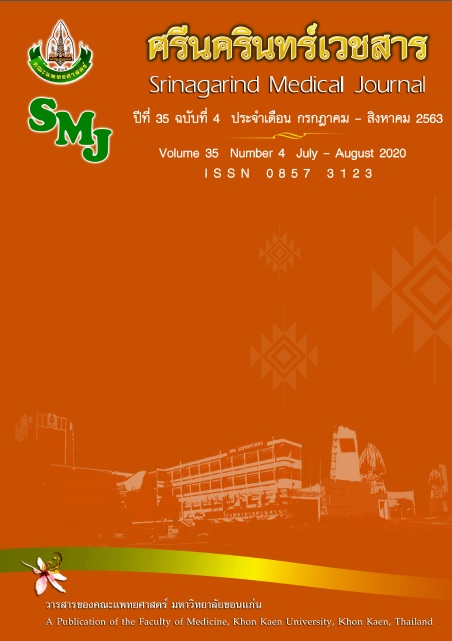Seasonal Fluctuation of Cercarial Trematode Infections in Freshwater Snails of Bithynia Siamensis Goniomphalos from In-And Out-Season Rice Paddy Fields, Khon Kaen Province, Thailand
Abstract
การผันแปรของฤดูกาลต่อความชุกของการติดเชื้อตัวอ่อนระยะเซอร์คาเรียของพยาธิใบไม้ในหอยน้ำจืด Bithynia siamensis goniomphalos ในนาปรัง จังหวัดขอนแก่น ประเทศไทย
มณฑิชา ไชยแสง1, ชนิสฬา เสรีวงษ์1,จักรกฤษณ์ ไชยยศ1, นัยนา เสนาศรี2, อภิพร ถิ่นคำรพ สุวรรณไตรย์1, เทวราช หล้าหา1, สมาน เทศนา1*
1ภาควิชาปรสิตวิทยา คณะแพทยศาสตร์ มหาวิทยาลัยขอนแก่น
2ภาควิชาประมง คณะเกษตรศาสตร์ มหาวิทยาลัยขอนแก่น
หลักการและวัตถุประสงค์: การติดเชื้อพยาธิใบไม้เป็นปัญหาที่สำคัญทางระบบสาธารณสุขของประเทศไทย วัตถุประสงค์ของการศึกษานี้เพื่อศึกษาอัตราความชุกของการติดเชื้อตัวอ่อนระยะเซอร์คาเรียของพยาธิ- ใบไม้ในหอย Bithynia siamensis goniomphalos และวิเคราะห์ความสัมพันธ์ ระหว่างการติดเชื้อและ ปัจจัยต่าง ๆ
วิธีการศึกษา: การศึกษาความชุกของการติดเชื้อตัวอ่อนระยะเซอร์คาเรียของหอย B. siamensis goniomphalos สุ่มเก็บตัวอย่างในนาปรัง 2 แหล่งพื้นที่จังหวัดขอนแก่น (มกราคม 2557-กุมภาพันธ์ 2558)
ผลการศึกษา: พบหอยติดเชื้อพยาธิใบไม้ร้อยละ 2.82 (พบระยะเซอร์คาเรีย 14 กลุ่ม) กลุ่มที่มีความชุกของ การติดเชื้อมากที่สุดคือ Xiphidiocercariae ชนิด virgulate 2 ส่วนในนาปรังแหล่งที่ 2 พบหอยที่ติดเชื้อร้อยละ 2.67 (พบระยะเซอร์คาเรีย 11 กลุ่ม) หอยเพศเมียมีความชุกของการติดเชื้อกลุ่ม Ophthalmo- xiphidiocercariae และ Pleurolophocercous มากกว่าหอยเพศผู้ หอยขนาดใหญ่มีความชุกของการติดเชื้อ กลุ่ม Xiphidiocercariae (ชนิด virgulate 1 2 และ 3) Ophthalmoxiphidiocercariae และ Pleurolo-phocercous มากกว่าหอยขนาดกลาง พบความชุกของ การติดเชื้อ Xiphidiocercariae ชนิด virgulate 2 Ophthalmoxiphidiocercariae และ Pleurolophocercous มากกว่าหอยที่พบในฤดูร้อน ในฤดูหนาว พบความชุกของการติดเชื้อ Xiphidiocercariae ชนิด virgulate 2 Xiphidiocercariae ชนิด virgulate 3 Ophthalmoxiphidiocercariae และ Pleurolophocercous มากกว่า หอยที่พบในฤดูร้อน แต่ปัจจัยของ อุณหภูมิ ปริมาณน้ำฝน และความเค็มต่อความชุกของการติดเชื้อ พบว่า ไม่มีนัยสำคัญทางสถิติ
สรุป: หอย B. siamensis goniomphalos สามารถเป็นโฮสต์กลางพยาธิใบไม้ได้หลายชนิด หอยเพศเมีย และหอยขนาดใหญ่มีโอกาสการติดเชื้อพยาธิใบไม้สูงกว่าหอยเพศผู้และหอยขนาดกลาง
คำสำคัญ: ความชุกของการติดเชื้อตัวอ่อนระยะเซอร์คาเรีย; หอย Bithynia siamensis goniomphalos; นาปรัง
Background and Objective: Trematode infections have been considered as important public health in Thailand. This study aimed to investigate the prevalence of trematode infections in Bithynia siamensis goniomphalos snails and analyze the association between prevalence of trematode infections with many factors.
Method: Cercarial infections in B. siamensis goniomphalos were studied in 2 localities of in- and out-season rice paddy fields in Khon Kaen Province (January 2014-February 2015).
Results: The average prevalence of cercarial infections in snails during the studying period was 2.82% (14 types of cercariae) in locality 1 and 2.67% (11 types of cercariae) in locality 2. The prevalence of cercarial infections with Ophthalmoxiphidiocercariae and Pleurolophocercous in female were higher than male snail. The prevalence of cercarial infections with Xiphidiocercariae (type virgulate 1, 2, and 3), Ophthalmoxiphidiocercariae, and Pleurolophocercous in large-sized snails were higher than medium and small-sized snails. Snails which were found in rainy season were higher prevalence of infection with Xiphidiocercariae type virgulate 2, Ophthalmoxiphidiocercariae and Pleurolophocercous than hot-dry season. Snails which were found in cool-dry season were higher prevalence of infection with Xiphidiocercariae (type virgulate 2 and 3), Ophthalmoxiphidiocercariae, and Pleurolophocercous than hot-dry season. But the prevalence of cercarial infections in the correlation factors of mean daily air temperature, average monthly rainfall, and salinity were not different significantly.
Conclusions: Bithynia siamensis goniomphalos snails served as intermediate host of various trematodes. Female snail was higher prevalence of infection than male snail. Large-sized snails were higher prevalence of infection than were medium-sized snails.
Keywords: cercarial infection; Bithynia siamensis goniomphalos; in- and out-season rice paddy field


